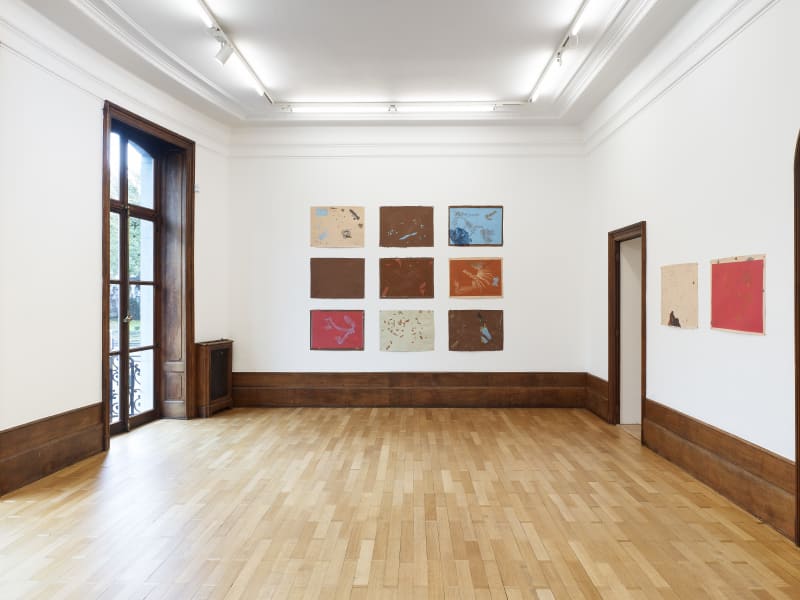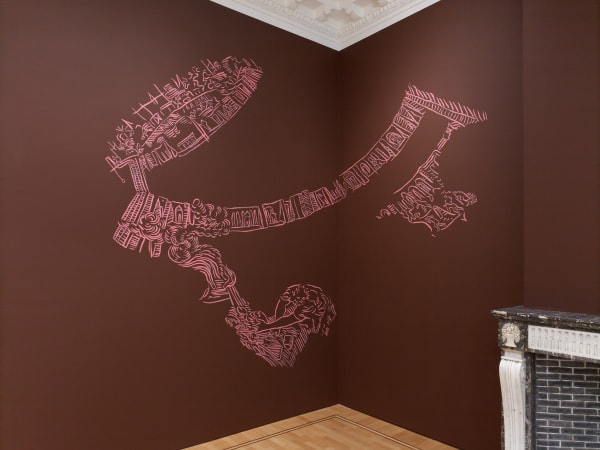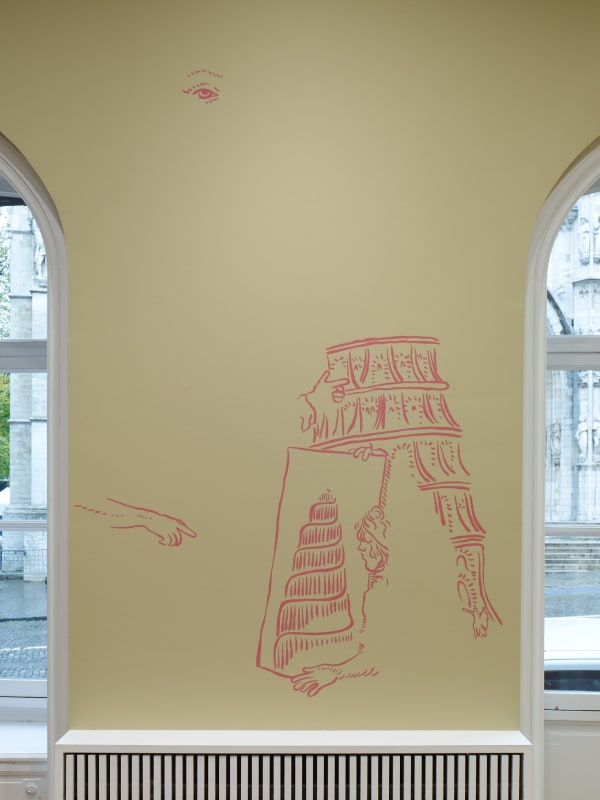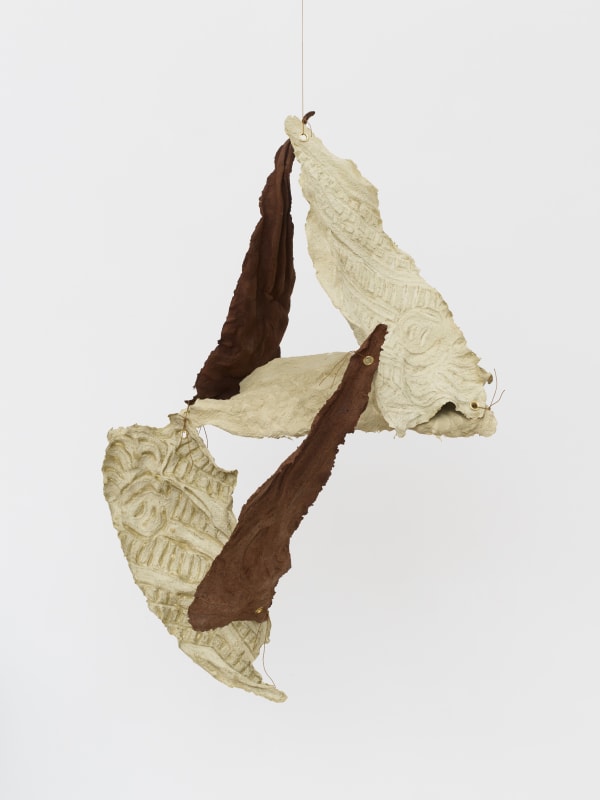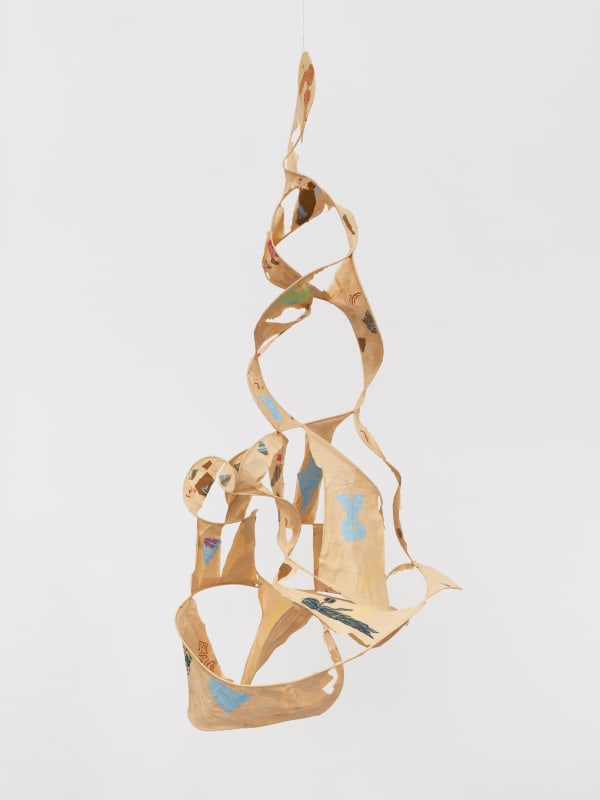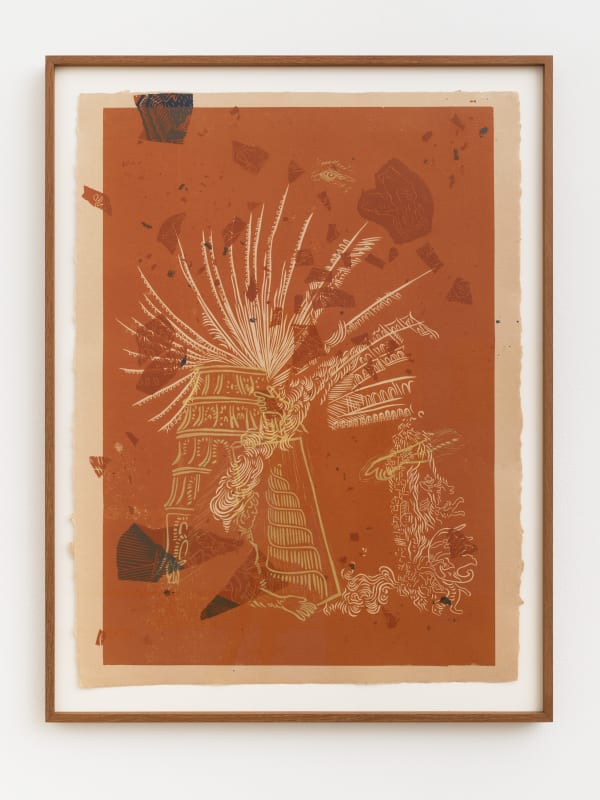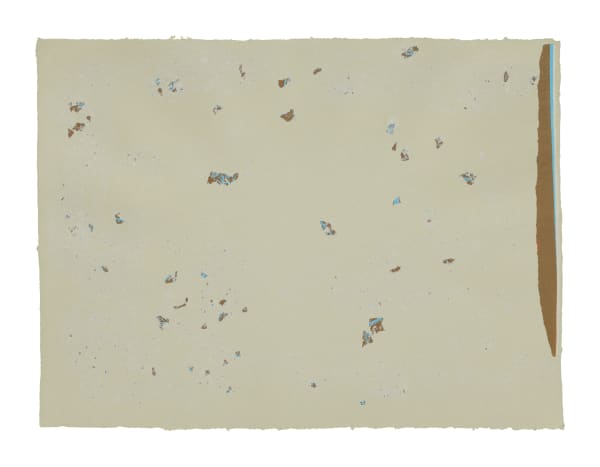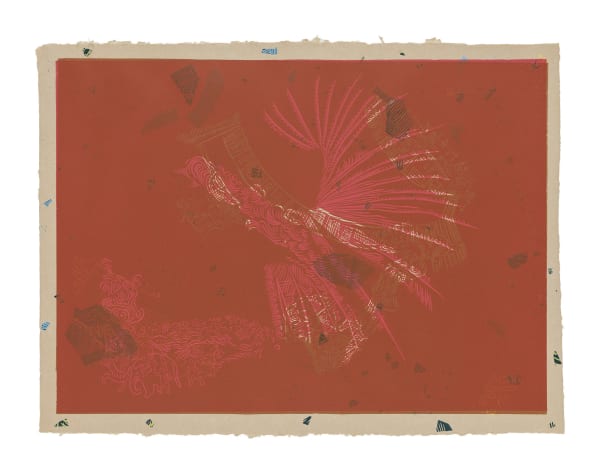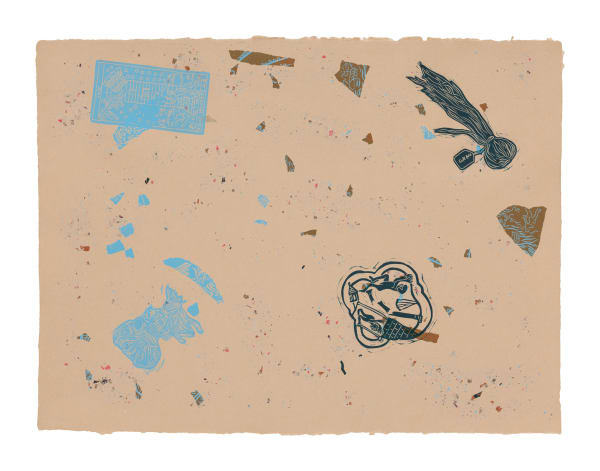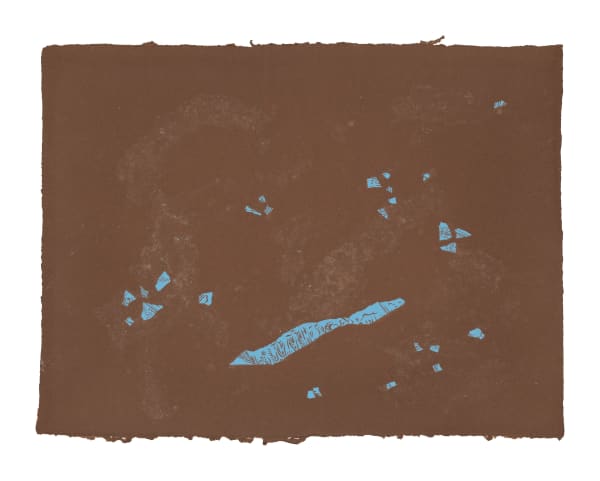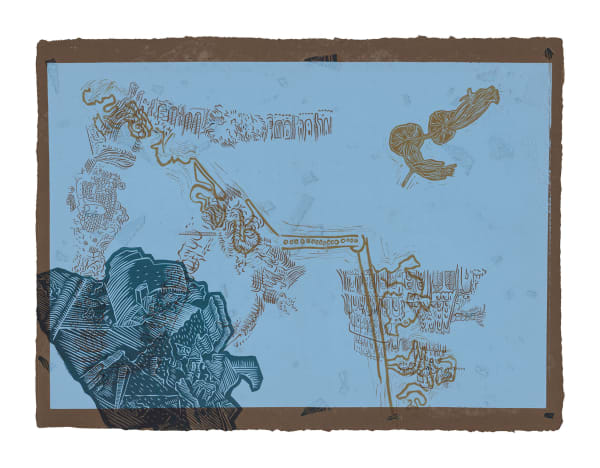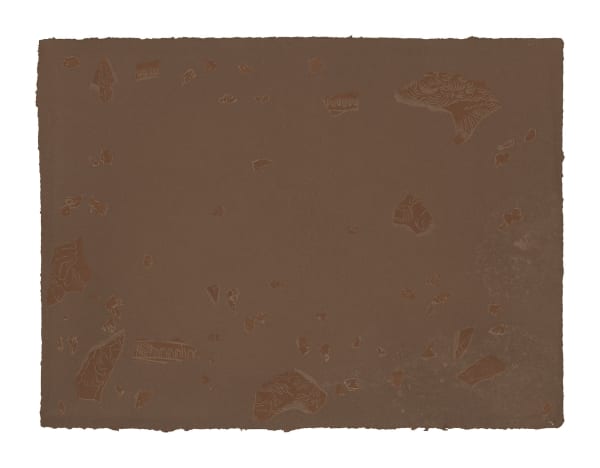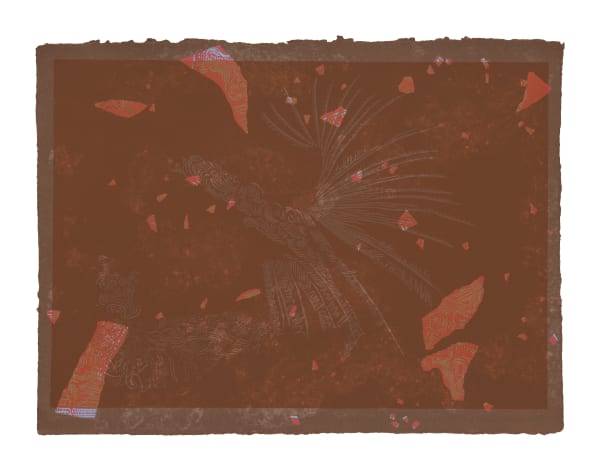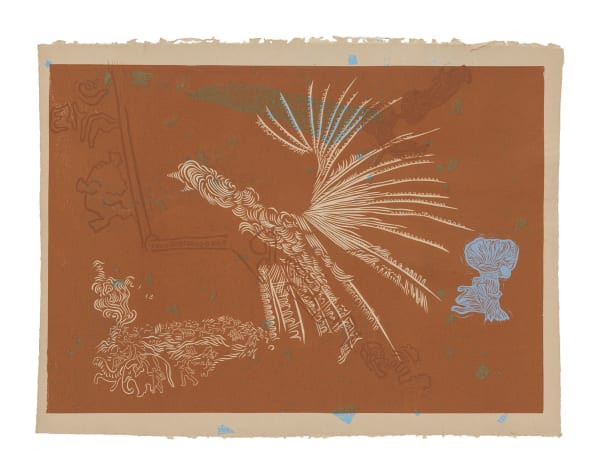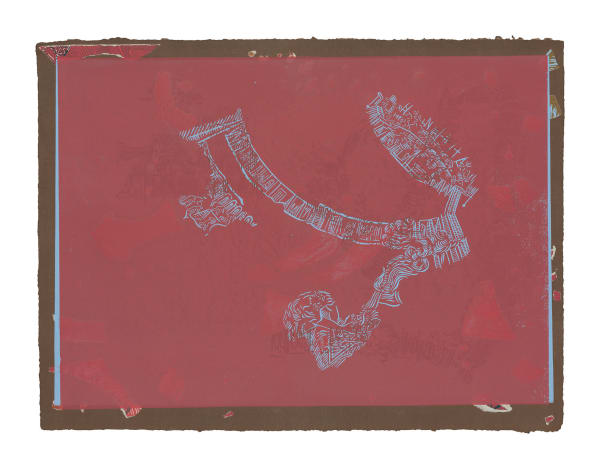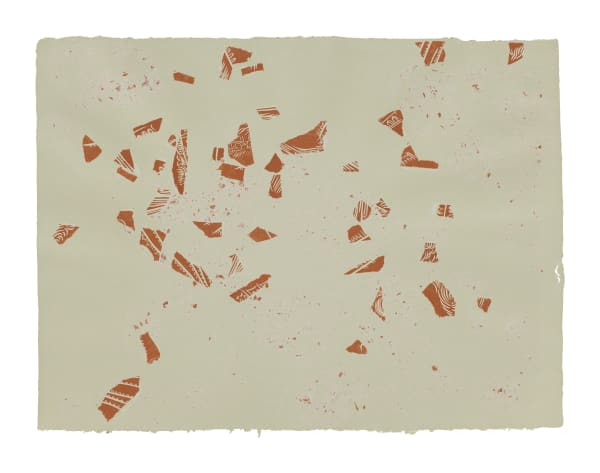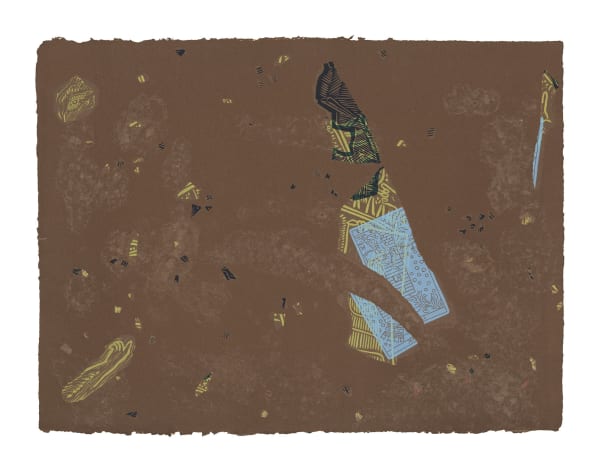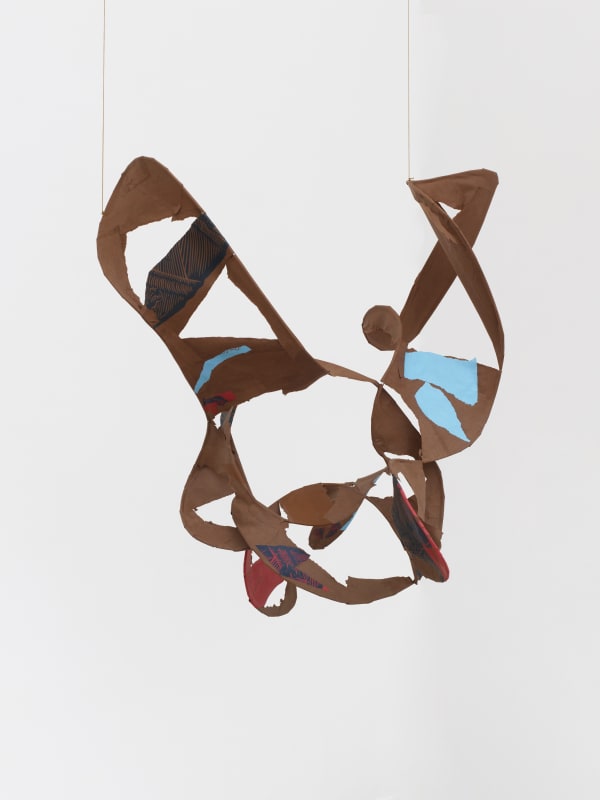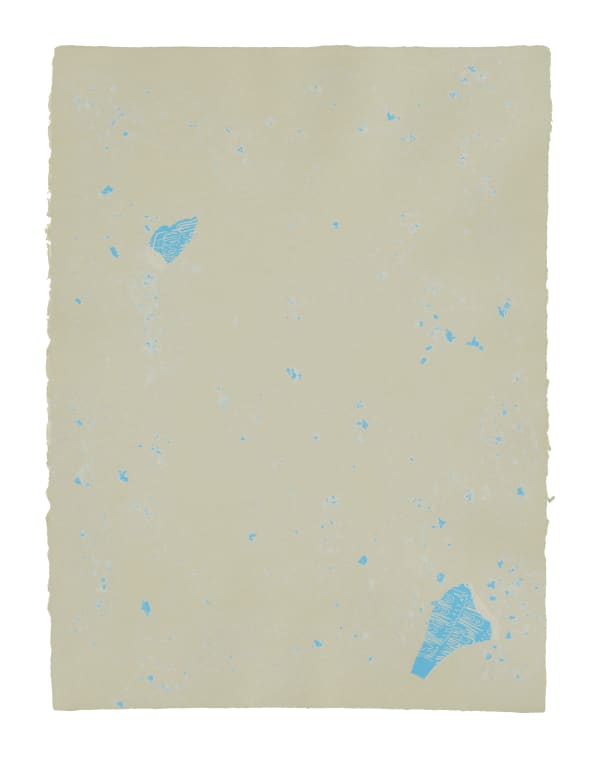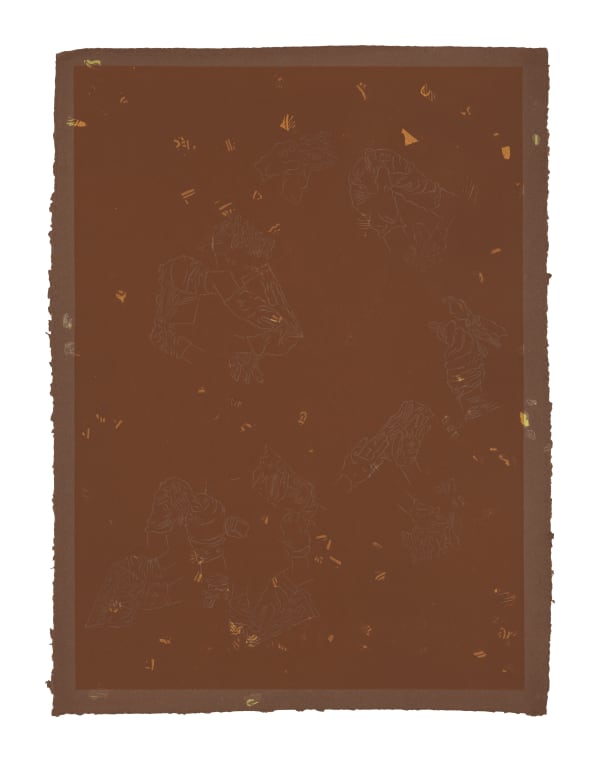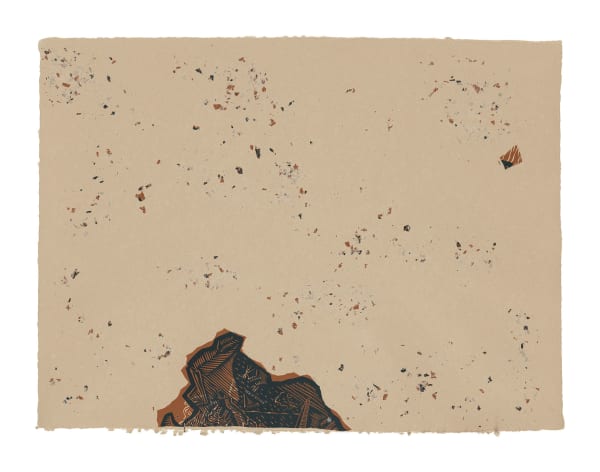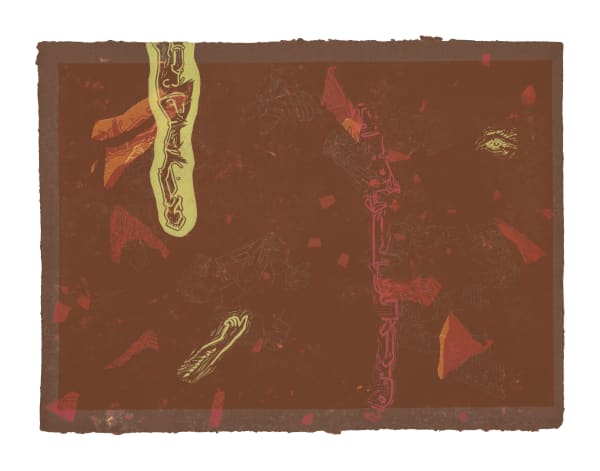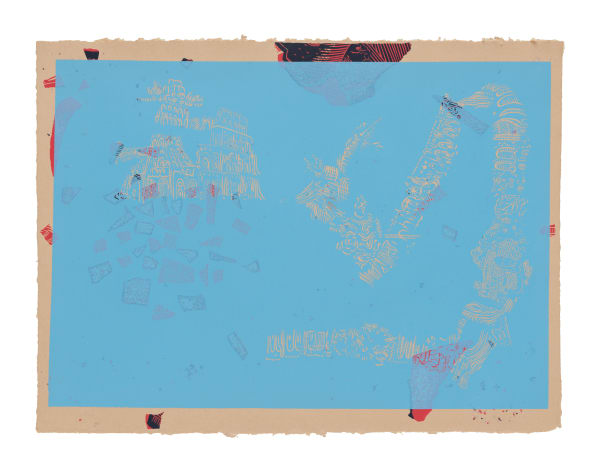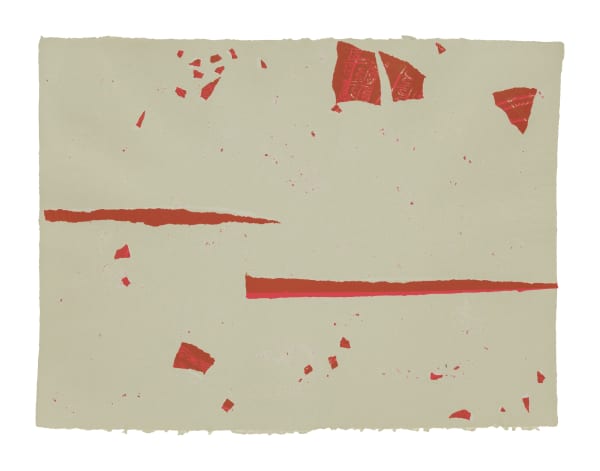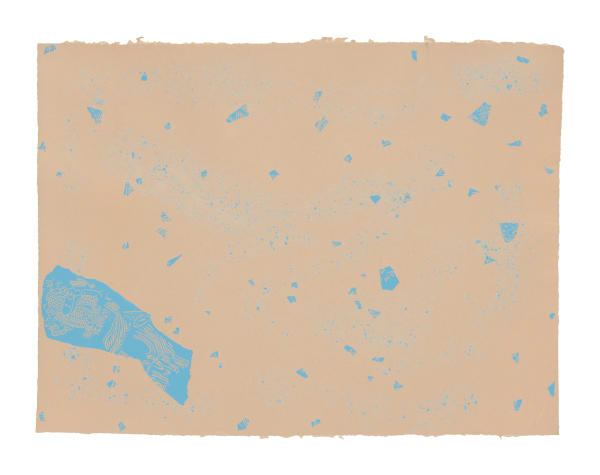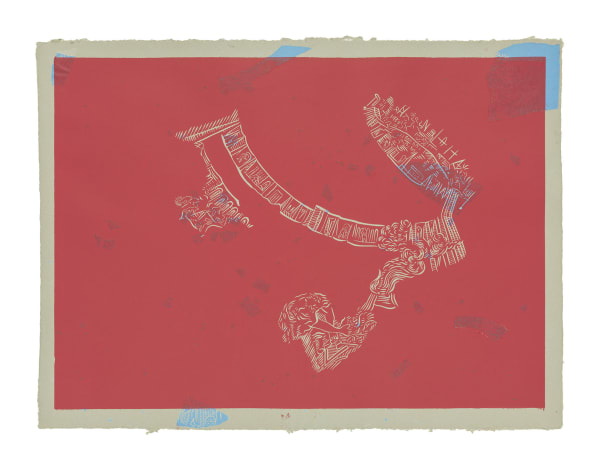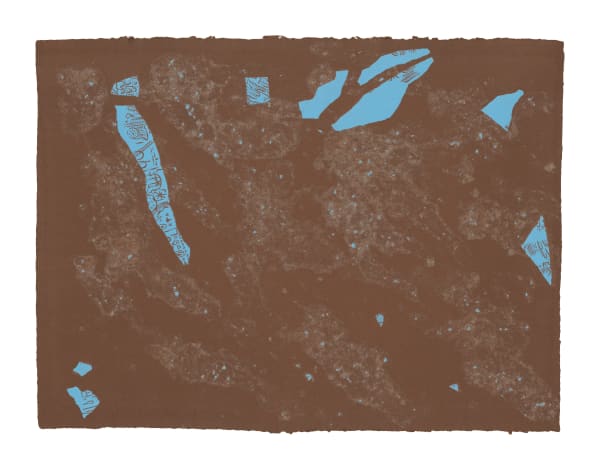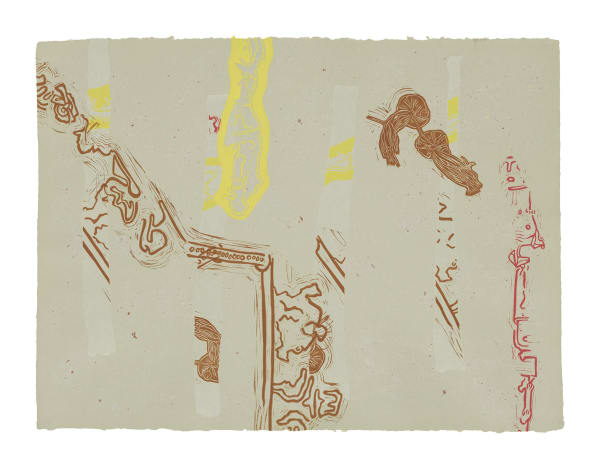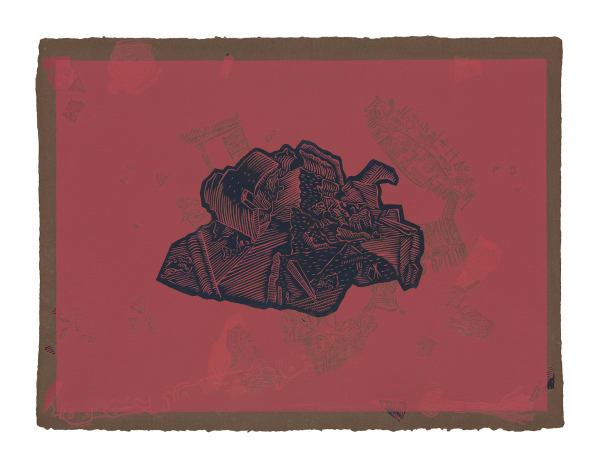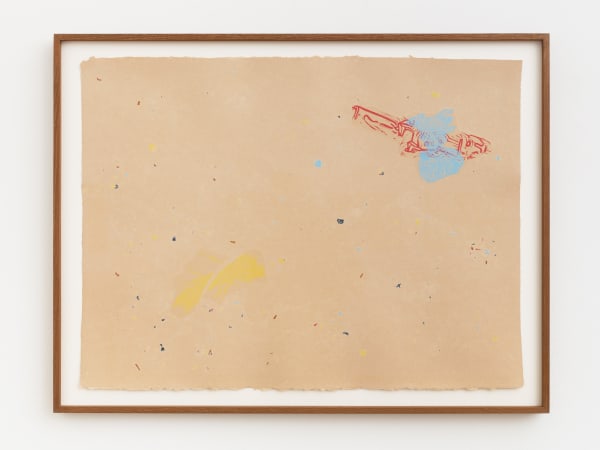Cada cosa es Babel Mariana Castillo Deball
“And what happens if we look the other way around, if we read contemporary art as future archaeology?”
— Mariana Castillo Deball
An object, eroded by time, crumbles in the palm of a hand. A tower collapses. A stonemason is hammering, chiseling stones. In her second solo exhibition at Mendes Wood Brussels, Cada cosa es Babel, Mariana Castillo Deball shows a selection of linocut prints on handmade paper, made in collaboration with paper producer Gangolf Ulbricht and printed at Keystone Editions, both in Berlin. For this series, the artist started by drawing deconstructed fragments of existing imagery of the tower of Babel – details from seventeenth-century engravings and the paintings of Pieter Bruegel the Elder, among others – and remixing these elements into new constellations that make up new layers of stories. As the title of the exhibition suggests: everything is Babel; everything tells a story and leaves a mark, even, or indeed precisely, where it fails and crumbles, leaving behind its origins.
“And it came to pass, as they journeyed from the east, that they found a plain in the land of Shinar; and they dwelt there. And they said one to another, Go to, let us make brick, and burn them thoroughly (…) And they said, Go to, let us build us a city and a tower, whose top may reach unto heaven; and let us make a name, lest we be scattered abroad upon the face of the whole earth” [11:2-4]. This marks the beginning of the story of Babel in the book of Genesis in the Christian Old Testament. The construction of the tower was cut short when god created a confusion of tongues – the multiplication of languages. Some scholars and historians have asked at which point this story begins to make sense to us as a story: in the plotlessness of a universal language, efficiently progressing towards a unified goal, or in its turn of plot, when people stop making sense to each other as they speak, suddenly, in different tongues?1 One interpretation of the story is that Babel has “made its name”, not in spite of the divine spell but because of it. The Hebrew name Babel (בבל) derives from the verb balal, which means to confuse or confound. The Arabic noun بَلْبَلة or balbala refers to disorder, confusion, and chaos.2 It may be the case that the English word babble has its origins in the word Babel, although it could also be an onomatopoeia for the sound that babies make before acquiring linguistic abilities. In either case, Babel, or babble, is what comes before and after a universal language that is set to unite people on earth with the divine knowledge of the heavens.
Jacques Derrida writes that “[t]he ‘tower of Babel’ does not merely figure the irreducible multiplicity of tongues; it exhibits an incompletion, the impossibility of finishing, of totalizing, of saturating, of completing something on the order of edification, architectural construction, system, and architectonics.”3 In a recent text in Ixiptla, a research journal edited by Mariana Castillo Deball, she writes that the forum of ancient Greek society is both a physical space and the people who gather in it.4 Something similar can be said about the tower of Babel. It is both architecture and the materialization of a monolithic language, or what such language strives to achieve: the utopian project of absolute (heavenly) knowledge, which is bound to fail. And Babel, as Derrida points out, is also the failure itself, which signifies the event in its trace. Babel in ruins. This failure is told through the scattering of people in different directions “upon the face of the whole earth”, and this scattering also finds its visual echo in the works shown in this exhibition.
The drawings by Mariana Castillo Deball show the tower in various stages of building and collapse. In one drawing, a woman is holding the design of the tower, while another portrays a community of builders having set up camp in the vicinity of the tower that is under construction. Another drawing shows Babel in ruins. Deball includes other pictorial elements, such as ethnographic objects from the Museu Nacional in Rio de Janeiro, Brazil, including clay figurines made by the Karajá Indigenous people from Central Brazil, as well as petecas (old shuttlecock-like objects made from straw and feathers for a game similar to present-day badminton).5 These motifs, which have trickled in from other projects the artist worked on simultaneously – just like Babel, as a story, a building, and a ruin – are of ongoing interest to her.
Having transformed these drawings into linocuts, Castillo Deball printed them on paper made by Gangolf Ulbricht, a collaborator with whom she has worked before. From these prints, which she destroyed and tore into snippets of different sizes, she created new sheets of paper in three different colors: grapefruit pink, pistachio green, and chocolate brown. These 56 x 76 cm paper sheets are reminiscent of an archaeological excavation site, with shards of pottery captured in the soil, frozen in time. While some of these papers are kept in this state, others serve as surface and background for a new round of prints, so that the linocut drawings begin to repeat themselves through different layers.
A story progresses through its twists of plot and the passage of time. This also reflects how our relationship with things, human-made things, intensifies over time. Multiple readings are possible as the object is perceived through different eyes; it no longer speaks for itself. More than presenting a single image that emerges from a process, the works featured in this exhibition reveal the ongoing process of the artist at work, the practice of telling through matter and time – story upon story in an ongoing construction aspiring towards perfection but leaving behind fragments in its wake.
— MM Goosen
[1] See for instance: Jean Benet, The Construction of the Tower of Babel. Translated by Adrian Nathan West. Wakefield Press, 2017.
2 For more information about the reception of the Babel myth in Arabic cultures and language, see: Abdelfatah Kilito, The Tongue of Adam. Translated by Robyn Creswell. New Directions, New York: 2016.
3 In: Jacques Derrida, Des Tours de Babel, translated by Joseph F. Graham. In: Graham ed., Difference in Translation. Cornell University Press, 1985.
4 Mariana Castillo Deball, About the Book’s Grid in: Ixiptla, Spring 2023, Vol. V, Amarantus. Bom Dia Boa Tarde Boa Noite, Berlin 2023. pp.7-19.
5 On September 2, 2018, there was a fire at the Museu Nacional in Rio de Janeiro which burned down its entire collection. This is the subject of Castillo Deball’s exhibition at Pivô in São Paulo, A Noite, which opened in September 2023, on the same date as the fire.
-
 Mariana Castillo Deball
Mariana Castillo Deball -
 Mariana Castillo Deball
Mariana Castillo Deball -
 Mariana Castillo Deball
Mariana Castillo Deball -
 Mariana Castillo Deball
Mariana Castillo Deball -
 Mariana Castillo Deball
Mariana Castillo Deball -
 Mariana Castillo Deball
Mariana Castillo Deball -
 Mariana Castillo Deball
Mariana Castillo Deball -
 Mariana Castillo Deball
Mariana Castillo Deball -
 Mariana Castillo Deball
Mariana Castillo Deball -
 Mariana Castillo Deball
Mariana Castillo Deball -
 Mariana Castillo Deball
Mariana Castillo Deball -
 Mariana Castillo Deball
Mariana Castillo Deball -
 Mariana Castillo Deball
Mariana Castillo Deball -
 Mariana Castillo Deball
Mariana Castillo Deball -
 Mariana Castillo Deball
Mariana Castillo Deball -
 Mariana Castillo Deball
Mariana Castillo Deball -
 Mariana Castillo Deball
Mariana Castillo Deball -
 Mariana Castillo Deball
Mariana Castillo Deball -
 Mariana Castillo Deball
Mariana Castillo Deball -
 Mariana Castillo Deball
Mariana Castillo Deball -
 Mariana Castillo Deball
Mariana Castillo Deball -
 Mariana Castillo Deball
Mariana Castillo Deball -
 Mariana Castillo Deball
Mariana Castillo Deball -
 Mariana Castillo Deball
Mariana Castillo Deball -
 Mariana Castillo Deball
Mariana Castillo Deball -
 Mariana Castillo Deball
Mariana Castillo Deball -
 Mariana Castillo Deball
Mariana Castillo Deball -
 Mariana Castillo Deball
Mariana Castillo Deball -
 Mariana Castillo Deball
Mariana Castillo Deball -
 Mariana Castillo Deball
Mariana Castillo Deball -
 Mariana Castillo Deball
Mariana Castillo Deball -
 Mariana Castillo Deball
Mariana Castillo Deball -
 Mariana Castillo Deball
Mariana Castillo Deball -
 Mariana Castillo Deball
Mariana Castillo Deball -
 Mariana Castillo Deball
Mariana Castillo Deball -
 Mariana Castillo Deball
Mariana Castillo Deball -
 Mariana Castillo Deball
Mariana Castillo Deball -
 Mariana Castillo Deball
Mariana Castillo Deball
